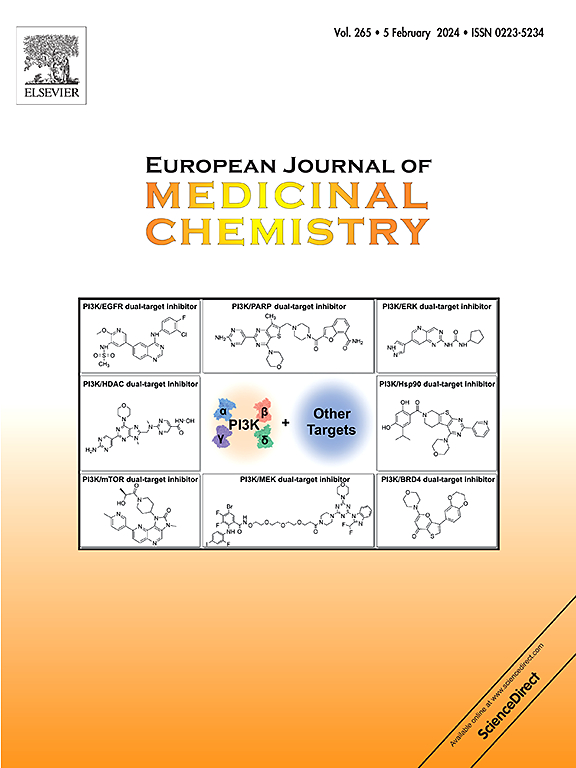Tissue factor derived β-hairpin peptides that bind and inhibit FVII activity
IF 6
2区 医学
Q1 CHEMISTRY, MEDICINAL
引用次数: 0
Abstract
The formation of the Tissue Factor(TF):Factor VII(FVII) complex is a pivotal event that initiates coagulation; targeting this early step allows for the prevention of the subsequent cascade amplification driven by positive feedback loops. For this reason, the TF:FVII complex is attracting increasing interest as a potential therapeutic target for regulating the coagulation cascade in a specific and timely manner. In order to generate TF-mimics capable of inhibiting this protein-protein interaction, we have designed four small cyclic peptides that simulate a TF region containing the two antiparallel β-strands: 106-110 (RVFSY) and 123-128 (EPLYEN). These strands are known to interact with FVII at well-known hot spots surrounding residues 365-369. With the aim of obtaining structures as similar as possible to the corresponding region of TF and therefore able to interact better with FVII, the four combinations of proline-proline dipeptides resulting from the four permutations of D-Pro and L-Pro have been introduced between the two strands. These strands have been connected on the opposite side by a disulphide bond in order to stabilise the resulting structures and also make them more resistant to protease action. The two cyclopeptides with the D-Pro-L-Pro and D-Pro-D-Pro moieties adopt β-hairpin-like conformations that recapitulate the structure of the two strands, as demonstrated by CD, NMR and molecular simulation studies. They also bind FVII and inhibit its activity in a Factor X-generating chromogenic assay. The other two peptides are significantly more disordered and are inactive in the same tests. Overall, the data validate the peptide design and confirm the region 365-369 of FVII as a target site for the design of coagulation inhibitors.

结合和抑制FVII活性的组织因子衍生的β-发夹肽
组织因子(TF)的形成:因子VII(FVII)复合物是启动凝血的关键事件;针对这一早期步骤,可以防止由正反馈回路驱动的后续级联放大。正因如此,TF:FVII复合物作为一种特异性和及时调节凝血级联的潜在治疗靶点正引起人们越来越多的兴趣。为了生成能够抑制这种蛋白-蛋白相互作用的TF模拟物,我们设计了四个小的环状肽来模拟含有两条反平行β-链的TF区域:106-110 (RVFSY)和123-128 (EPLYEN)。已知这些链在残基365-369周围的著名热点与FVII相互作用。为了获得与TF相应区域尽可能相似的结构,从而能够更好地与FVII相互作用,在两条链之间引入了由D-Pro和L-Pro四种排列产生的脯氨酸-脯氨酸二肽的四种组合。这些链在另一侧通过二硫键连接,以稳定生成的结构,并使它们更能抵抗蛋白酶的作用。CD、NMR和分子模拟研究表明,具有D-Pro-L-Pro和D-Pro-D-Pro基团的两个环肽采用β-发夹状构象,再现了两条链的结构。它们还结合FVII并在因子x生成显色试验中抑制其活性。在同样的测试中,其他两种多肽明显更混乱,并且不活跃。总的来说,这些数据验证了肽设计,并确认FVII的365-369区域是设计凝血抑制剂的靶点。
本文章由计算机程序翻译,如有差异,请以英文原文为准。
求助全文
约1分钟内获得全文
求助全文
来源期刊
CiteScore
11.70
自引率
9.00%
发文量
863
审稿时长
29 days
期刊介绍:
The European Journal of Medicinal Chemistry is a global journal that publishes studies on all aspects of medicinal chemistry. It provides a medium for publication of original papers and also welcomes critical review papers.
A typical paper would report on the organic synthesis, characterization and pharmacological evaluation of compounds. Other topics of interest are drug design, QSAR, molecular modeling, drug-receptor interactions, molecular aspects of drug metabolism, prodrug synthesis and drug targeting. The journal expects manuscripts to present the rational for a study, provide insight into the design of compounds or understanding of mechanism, or clarify the targets.

 求助内容:
求助内容: 应助结果提醒方式:
应助结果提醒方式:


